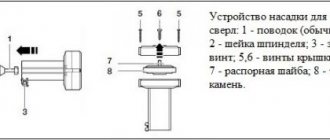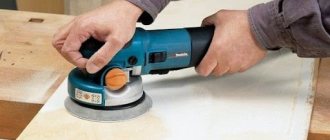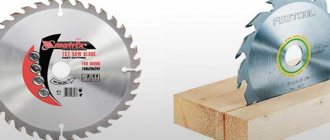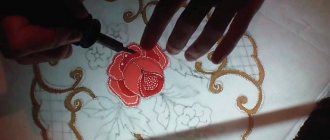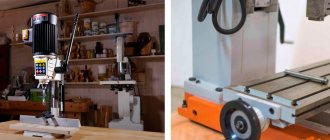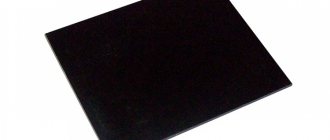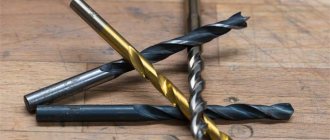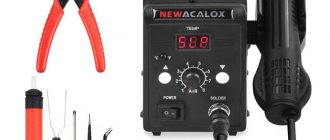Areas of use and design features
The market for tools and accessories is full of a variety of wood drill bits to choose from. Woodworking tools are used in accordance with the specifications, design and type of work being performed. The functionality of one drill can be limited; under heavy loads it can break and damage the part. To eliminate curious cases, a wood drill is used in accordance with technical parameters.
A home craftsman must distinguish between varieties and types in order to perform the safest and highest quality work possible.
When purchasing, you should pay attention to the quality of the gimlet; the main structure and cutting part must be free of chips and cracks, well processed and evenly sharpened.
Based on the color scheme, it is possible to determine the treatment and purpose:
- A steel-colored product indicates a lack of processing.
- A yellow-bronze tint is obtained by metal during processing to relieve metal stress.
- The bright golden color indicates titanium nitride treatment, which is used for durability and reliability of the countersink.
- The strength of the tool is increased by superheated steam; the black color indicates this when purchasing.
An example of using a wood drill
It is necessary to pay attention to the size of the drill. A long wood drill is not always useful for the farm, since the longer the drill, the larger its diameter. Long gimlets are used for processing soft wood at medium tool speeds. The larger the size indicators, the lower the revolutions should be, because there is a possibility of the drill breaking off and damaging the workpiece.
It is necessary to correctly select the ratio of weight to the required hole. The greater the length and diameter of the wood drill, the lower the drill speed should be.
Compliance with this rule will help preserve the instrument for as long as possible. If a twist drill cannot produce the required hole size in wood, a ring type drill is used. The appearance of ring drills for wood resembles crowns and has a ring with jagged edges. The length of this type of product does not differ in special parameters, and the width of the outlet hole can be made up to 60 mm. The tool is also allowed to work with soft materials - plastic and plasterboard.
How to drill wood?
For quality work, it is enough to follow a few recommendations:
- Accurate markings. In order for the holes to be in the right place, it is necessary to make preliminary markings.
- If you need to make a through hole, first use a small drill, then drill the workpiece with a large drill. This method will avoid chipping.
- For blind holes, tape is wound around the drill from the desired edge.
Woodworking requires high-quality tools and adherence to technology. With a good tool, drilling into wood is easy.
More articles
- Laying laminate diagonally: features of diagonal laying laminate
- Floor construction with adjustable joists
- Clinker tiles for floor finishing: ceramic clinker steps
- Components of a water heated floor
- Proper floating floor design
- Floor design in a frame house
- General floor design
- Industrial floors: types and features of arrangement in different rooms
- Turnkey construction. What it is?
- Floor installation in a prefabricated hangar
Selecting the required type of drills for a home workshop
The sets of tools for woodworking included in power tools are not very diverse. Therefore, for comfortable work, you select your own set of tools, depending on the type and material of the work. Wood drills are divided into types, depending on the type and hardness of the material. It is necessary to choose a high-quality wood drill; the main characteristics should differ in conditional parameters.
Spiral
The most common type are twist drills for wood.
Spiral
Different diameters from 3 to 50 mm allow you to perform a different range of work; the pointed end is necessary for balancing the electric drill. A cone-shaped shank is used in cases where it is necessary to adjust the drilling point. It is worth taking into account the hardness of the rocks and the diameter of the gimlet when making parts. For example, with a drill with a diameter of 12 mm, it is possible to drill soft material at a speed of about 2000 per minute, when with hard rocks the speed is halved. Using the woodworking kit in accordance with the technical regulations and for its intended purpose can extend the service life and maintain the sharpness of the cutting element.
Long drills
Drills of unique and different lengths are used in non-standard situations; it must be taken into account that the longer the length, the larger the diameter.
Long wood drill
The increased length can cause the tool to be heavy; a conventional electric drill is not able to rotate a heavy shaft. To drill lengths with a drill, a mixer is used - a stirrer operating at low speeds with low force.
Screw
A subcategory of spiral products are screw drills. The drilling process occurs by drilling against the growth of wood fibers. The screw drill also comes in different diameters, lengths and weights. For example, a wood drill with a diameter of 4 centimeters will have a length of 600 cm and a weight of just under 1.3 kilograms. A design feature is the presence of a threaded screw, which allows the removal of wood chips. The threaded tip is used for precise installation of the tool when working with materials.
Wood screw drill
It is important to understand that a smaller drill diameter cannot be associated with an increased length of the product. There are narrow and long versions of the tool on the market, but a reliable process cannot be achieved with them due to the fragility of the material and the wrong choice of power tool speed.
Feather
The most balanced in weight and design is the feather type. The accuracy and quality of processing will not have high parameters, so this version of the gimlet is not applicable for decorative work.
Feather
Work is carried out at increased speed due to the lightweight design and simple adjustment. The hole width range can vary from 10 to 60 mm, depending on the type of structure. The length of the treated surface can be adjusted with a special adapter - an extension, which allows you to increase the depth to 30 centimeters. The process must be carried out without stress on the tool, since the drill can break when heated, due to its fragile design.
Forstner drill
Blind holes for fastening hinges, handles and other accessories are made using a Forstner drill. The cutting edges are located on the side plane, making it possible to process holes with a flat bottom. The main difference of the kit is that it does not heat up during operation and is capable of performing precise work based on the correct direction of drilling. The dimensions and diameter of the holes depend on the choice of instrument; an analogue of this type of instrument is a ballerina.
Forstner drill
The ballerina allows you to adjust the diameter of the future hole in the tree, thanks to a special mechanism. Buying one universal tool when working with wood can replace a whole set, and is convenient for storage and transportation.
Ring
The annular type of drills allows you to make large-diameter holes, also called crowns. The appearance implies a ring with jagged edges along the entire edge. It is common to use sets in which there is a different choice of equipment according to diameter.
Wood drill bit
The guide bur is located in the center of the disk, then there is a mechanism for attaching removable tips. The universal set allows you to process thin-walled products and materials.
Countersink
Drilled holes for connecting elements, bolts or screws, often need to be masked. The countersink is used in conjunction with a depth limiter for proper processing of wood.
Countersink
A replaceable centering tip for wood with a diameter of 4 mm is fixed using a clamping mechanism with a screw.
Flexible
It should be noted right away that the drill material cannot be flexible and has not yet been developed. The name of a flexible tool for work is a mechanism inserted into a cartridge, a kind of extension.
Flexible wood drill bit in use
The use of an adapter allows you to transfer the torque of a drill or screwdriver to a drill located in a hard-to-reach place. Varieties of small length and diameter are used; the design will not withstand a massive woodworking tool.
Best Drill Sets
In home workshops and industrial plants, drills of different sizes and diameters are required. Manufacturers produce sets for such cases, equipped with equipment of different diameters with shanks of the same type. The tool is of stable quality, and convenient packaging makes storage simple and convenient.
Bosch Promoline 2.607.019.435
The German set of metal drills contains 19 pieces of tools, with a diameter from 1 to 10 mm. A step of 0.5 mm allows you to select equipment with high accuracy. All products are made of hard alloy steel, which has undergone additional heat treatment. The sharpening angle ensures high quality drilling; the tool copes well with carbon steel, aluminum and other metals.
The cylindrical shank allows use with chucks of electric drills and small drilling machines. The set is supplied in a convenient box with an informative stand, where each drill diameter is labeled.
Advantages:
- Ideal geometry;
- Durability;
- High strength;
- Low price for its category;
- Small box size.
Flaws:
- Not detected.
Hammer 202-921 DR set No21
The universal set includes products for working on concrete and metal. The equipment is made of tool high-speed steel. The tool can be used for processing heat-resistant, carbon, corrosion-resistant steels and alloys. The edge sharpening angle of 135 degrees allows you to drill quickly and efficiently. The diameter is selected to work with the main types of rivets. The short pitch makes selection easier.
The tool for working with concrete has high-quality grinding, which helps create smooth holes and quickly remove construction dust from the hole being formed. Supplied in a convenient case that does not take up much space.
Advantages:
- Low price;
- Reliable fixation in the grooves of the box;
- The equipment can withstand intense loads;
- Stable geometry.
Flaws:
- Sometimes there is displacement of the tips.
Advantages and disadvantages
Each cutting set is designed to perform specific jobs under different operating conditions of the equipment.
Before processing wood, it is important to evaluate the type of hole required and the material. Properly performed preparatory work and the use of tools allow you to obtain high-quality results and durable operation of the devices.
The functionality is described in the instructions or on the product packaging; if there is no information, you must contact a specialist for clarification on the technical data.
Forstner drill
The tool is intended for making loops, belongs to specific equipment and is not widely used.
The design of the drill resembles a feather analogue, but has uneven edges. This consumable allows you to get a hole that has a flat bottom and edges, allowing you to install hinges without additional modification.
One such tool is sufficient, but it is precisely the diameter that these loops should be. To create standard hinges, the drill must have a diameter of 35 mm, for non-standard ones – 26 mm.
Features of wood drilling work
There are a huge number of products offered on the market. The varieties do not stop at the list presented; for example, to obtain conical tenons, plug-type drills are used. Holes in wooden structures can be made with any available material, even a milling cutter or drill.
Drilling technology depends on the thickness and density of the material. Usually the work is carried out initially with a drill of a smaller diameter to prevent chipping on the back side of the product. The process is preferably carried out on both sides according to the prepared markings. When this opportunity is not provided, a wooden beam is placed at the point where the drill exits the workpiece. To obtain the necessary recesses, the marks necessary to visualize the process are applied to the cutting element.
Techniques for drilling holes in wood
Countersink hole for screw head
There are situations when you need to drill a “blind” hole for a tenon joint. To do this, you need to use a feather drill with a limiter, which is placed on the drill according to the size of the drilling depth
It is more difficult to make holes in large-diameter wood, since the use of conventional cylindrical drills chips the surface of the material, spoiling its appearance. To successfully cope with this task, feather drills and annular cutters are used.
Drilling with feather drills
For successful drilling with feather drills, secure the wood firmly in a vice and press the tip of the drill bit against the surface of the material. Then drill (at low speed) the hole until the tip of the drill appears at the bottom of the wood. Stop drilling and remove the feather bit from the hole, then turn the wood over, clamp it in a vice and drill the hole on the other side. This will prevent the block from splitting when drilling.
Drilling with an annular cutter
Wood annular cutter
An annular cutter is used for drilling holes in wood with a diameter greater than 38 mm. Drilling begins with a small-diameter guide drill, structurally connected to the cutter in one piece. This guide serves as a guide for the annular cutter.
Here are some tips from professionals that will surely help you when drilling holes in wood:
a) for vertical drilling, you can install a square parallel to the drill; b) if you often have to do carpentry work, purchase a special stand for the drill, which allows you to hold the tool strictly vertically and controls the depth of the holes; c) be sure to use a vice when drilling to avoid splitting the wood; d) to ensure that the exit hole does not have chips, place it under wooden part with an unnecessary block and drill them together. This is especially applicable when making holes in a thin board; e) if you do not have a drilling depth limiter, wrap the drill at the limit location with bright electrical tape or masking tape.
Sharpening a wood drill is a useful skill
Intensive use of wood tools leads to loss of its cutting properties. Such a tool does not have to be sent for recycling; its ability to work can be restored by proper sharpening. In the absence of experience and small volumes of tools, it is possible to contact special workshops that provide sharpening services. To study the process on your own, you need to start with an unused drill, which, if damaged, can easily go to waste.
Methods for sharpening drills
A device for sharpening drills at home
Head position when sharpening
Obtaining a result is possible only if several conditions are met. The process is carried out manually, using a suitable file or using a grinding machine. In the latter case, it is necessary to maintain the temperature regime of the product, constantly pouring a stream of water or oil. Overheating will lead to loss of metal strength, unimportant work, in the absence of the ability to provide constant cooling, you just need to dip the product in a glass of water or oil every couple of seconds. Only compliance with the factory geometry parameters will make it possible to operate the cutting set as if it were in new condition.
Rating of drill manufacturers
| Nomination | place | manufacturer | rating |
| Rating of drill manufacturers | 1 | Haisser | 4.9 |
| 2 | Bosch | 4.9 | |
| 3 | Metabo | 4.8 | |
| 4 | DeWALT | 4.8 | |
| 5 | AEG | 4.7 | |
| 6 | Makita | 4.7 | |
| 7 | DIAGER | 4.7 | |
| 8 | VIRA | 4.6 | |
| 9 | Ryobi | 4.6 | |
| 10 | Zubr | 4.5 | |
| 11 | SIBRTECH | 4.5 | |
| 12 | Ineterskol | 4.5 | |
| 13 | Tulamash | 4.4 | |
| 14 | Inforce | 4.4 | |
| 15 | Anchor | 4.3 |
Understanding how to choose a drill, let’s move on to the rating, which has collected the best manufacturers based on the characteristics of their products and reviews from craftsmen. Experts analyzed the range of products, types of steel used, service life and practical experience of users, which helped to distinguish the companies in that order.
Haisser
Rating: 4.9
We gave first place in the ranking to a German manufacturer, known for its products not only in Europe and the CIS, but also in the USA. The company has production facilities at home and in China, so the quality of products, unfortunately, varies. But German drills are distinguished by sharp sharpening and a long service life. In terms of price, they occupy the middle place, which is what most users like in the reviews. The products are produced in two series: “Medium TN” and “Long TM”. The first line presents models with lengths from 3.4 to 15 cm, and the second from 5.6 to 20.5 cm. Products are sold both individually and in whole sets. The priority direction of drilling is metal.
Our experts singled out this manufacturer as the best because it produces a lot of drills with a cross-shaped cutting edge. Thanks to this design, the equipment easily “bites” into the material even without punching and does not move during the initial rotation. Also, the working part of the tool is always thinner than the shank, therefore it is less susceptible to wear when the drill falls into the chuck and continues to rotate.
Advantages
- fracture resistance;
- precise sharpening - can be used immediately;
- cross-shaped point on many drills for self-centering;
- reinforced rod;
- full range of drills for ceramics, cast iron, plastics, alloy steel.
Flaws
- the cost is more expensive than analogues;
- range for hand tools only;
- Victory tips on drills round off quite quickly;
- It is difficult to buy products made in Germany.
How to make large holes in walls? Choosing the optimal tool
Drilling large holes requires large nozzles, and they are different for wood and concrete. We will tell you which attachments to use for which tasks and recommend reliable drills.
To drill holes for air conditioner mounts, cable pulling, installation of a soldered pipe for water supply or connecting furniture structures, you will need a large drill. Although large nozzles for wood and concrete are somewhat similar, they are still intended for different tasks and they are not interchangeable. We will tell you about them and recommend a couple of good attachments for wood and concrete. We have already told you how to distinguish drills for wood, metal and concrete. Here we will focus on large attachments, which we do not use very often, but without which we can’t go anywhere in everyday life.
Color matters
Even by the appearance of the drill, you can determine its properties and qualities.
- The gray color indicates that this is an ordinary simple drill, without any additional processing.
- Cherny reports that the drill has been treated with hot steam and has increased wear resistance.
- Yellow means that the drill has been quenched and tempered (a procedure to relieve internal stress). Such products are even more wear-resistant, but are afraid of overheating.
- A bright golden color is usually characteristic of drills treated with titanium nitride, which reduces contact friction in the drilling area and perfectly hardens the surface of the tool.
Which material is better to choose a drill for wood, metal or concrete?
- Mild mild steel drills are inexpensive, but have poor edge retention and require frequent sharpening. They are only used for drilling wood; even working with deciduous rather than coniferous trees can significantly reduce their service life.
- High carbon steel drills are more durable than low carbon steel drills due to the material's hardening properties. If they overheat (for example, due to frictional heating during drilling), they lose their properties, which leads to destruction of the cutting edge. These bits can be used on wood or metal.
- High speed steel (HSS) is a type of tool steel. HSS bits are hard and much more heat resistant than high carbon steel. They can be used to drill through metal, hardwood and most other materials at faster speeds than carbon steel bits and have largely replaced carbon steels.
- Cobalt steel alloys are varieties of high-speed steel that contain more cobalt. They retain their hardness at much higher temperatures and are used for drilling stainless steel and other hard materials. The main disadvantage of cobalt steels is that they are more brittle than standard HSS.
- Tungsten carbide and other carbides are extremely hard and can drill through almost all materials while holding an edge longer than other bits. The material is expensive and much more brittle than steel.
Hence, they are mainly used for drill bit tips clamped or soldered onto a tip made of a less hard metal.
How to drill a log or thick beam? Of course with a screw drill
We continue to understand the equipment with which you can work on wood. In general, wood can be drilled with different drills; in the last article we analyzed the effectiveness of the Forstner drill, and figured out how and where it is recommended to use it.
There are a great many types of wood drills and it often happens that they are ideal for some jobs, but not suitable for others at all. Therefore, a home craftsman must understand what and how to drill into wood. Today's article will be about a screw drill, also called a twist drill.
It is for wood and will help out in cases where it is necessary to drill a deep hole. For example, you have a log house through which you need to stretch a water pipe or a bundle of cables. And only a twist drill can cope with thick wood. Of course, nothing prevents you from trying to use a regular perk, however, as I already said, drilling with it is inconvenient and it is not a guarantee that you will be able to complete the job.
Here is a photo:
As you can see, the tip is made in the form of a thin thread, which helps to screw in the drill perfectly at the initial stage of drilling. The ejection of chips occurs due to the screw edges (like any drill or brace), so drilling is easy. The shank is most often 6-sided, so the tool is securely mounted in the chuck of a drill or screwdriver.
It is necessary to work with such a drill at low speeds, so it is best to use a regular home drill with speed control or a powerful screwdriver with a high tightening torque.
But it is best, if possible, to use a low-speed drill with a speed of up to 800 (I recommend a rebir drill).
The most common use of such equipment is the fastening of logs. Workers who assemble log houses often come to our store and they buy “spirals” with a diameter of 25-28-30 mm and a length of 450-600 mm. As you know, in order to fasten the logs of a log house together, you need to drill them from above and insert iron reinforcement into the hole made. It is very important that the hole is drilled deeply, which is why a long drill is needed.
The standard range of lengths is as follows:
— 220 mm — 450 mm — 600 mm (the most popular).
To make holes with a diameter of 30 mm to a depth of 600 mm in wood, you need a very powerful power tool, so we recommend using a drill of at least 1000 Watt (and that is unlikely to be enough), as well as screwdrivers with a torque of at least 36 Nm. Of course, the most preferable option is a low-speed drill, which has a power of 1200 Watts; for such work you can’t imagine anything better. It is very powerful and easily pushes such a thick drill bit through solid wood.
The prices for such “consumables” are quite high, at least it is much more expensive than feather and Forstner drills. For example, 22*600 costs around 300 rubles. And the thickest ones come with a price tag of a piece of rubles. They are taken only when it is necessary to drill a hole in a log house for a sewer pipe, etc.
However, if you consider that the drill is powerful and heavy, and it is used to perform specific work, then you should not worry about the price. Because anyway, nothing else can drill through 3 logs at once.
